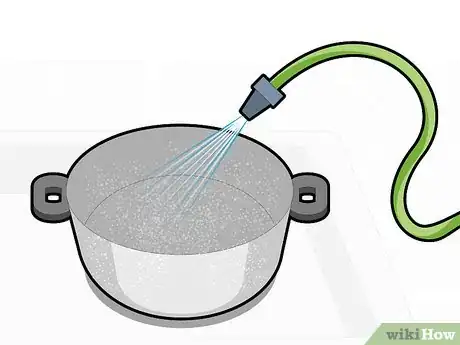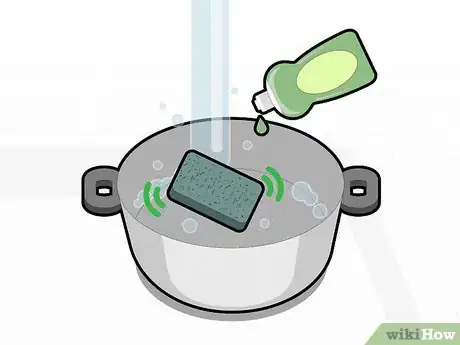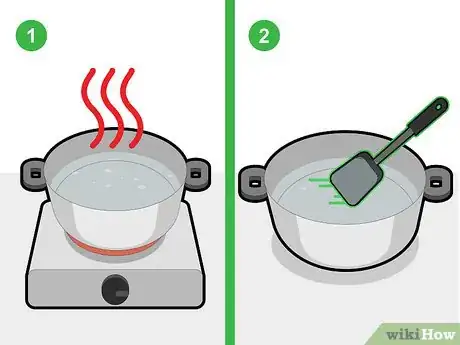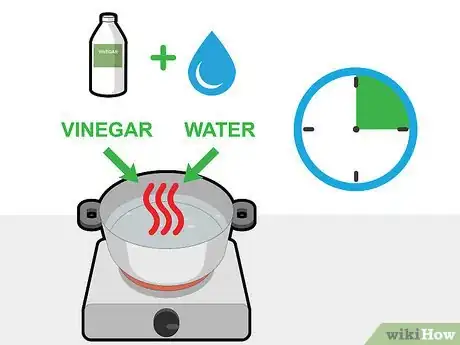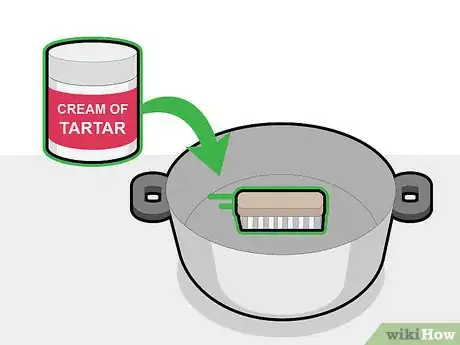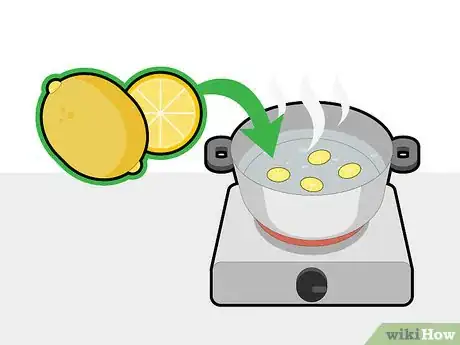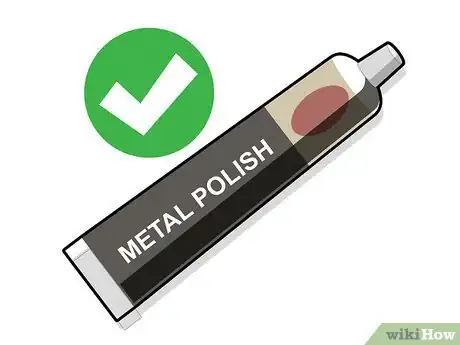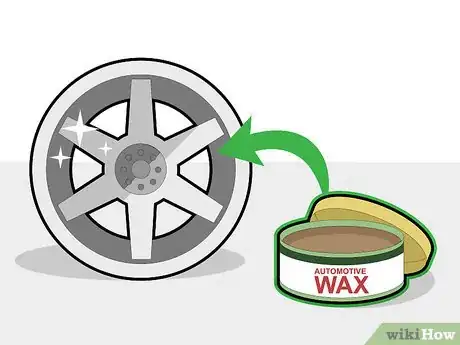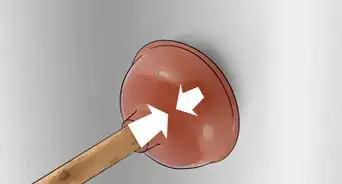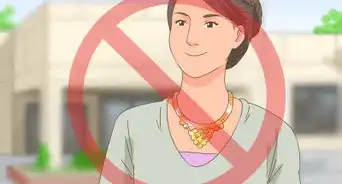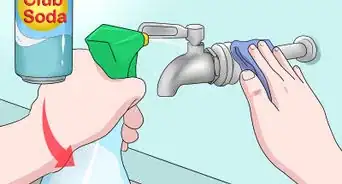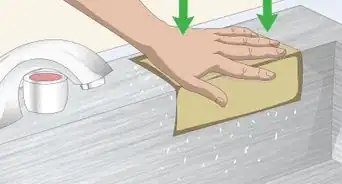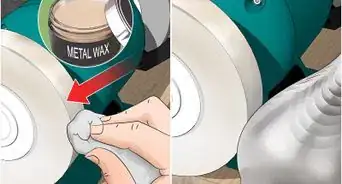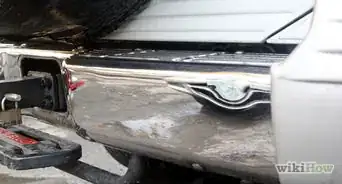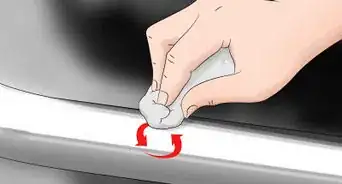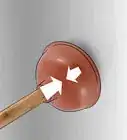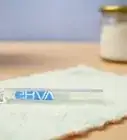This article was co-authored by Kadi Dulude. Kadi Dulude is a House Cleaning Professional and the Owner of Wizard of Homes, a New York City-based cleaning company. Kadi has over 10 years of experience and manages a team of over 90 registered cleaning professionals. Her cleaning advice has been featured in Architectural Digest and New York Magazine.
This article has been viewed 444,617 times.
Aluminum is a highly versatile material that is used to make many things, from cooking pans to bicycle wheels. Unfortunately, aluminum has the tendency to oxidize over time, meaning that the material accumulates a chalky, grey cast. Once you start to see this oxidation form, there are a number of ways to remove it. Begin by cleaning and scrubbing the aluminum to remove any debris from the surface. Then clean the aluminum with acidic cleaners and scrub to eliminate the oxidation.
Things You Should Know
- Rinse dust and debris off the aluminum surface with plain water before trying to remove oxidation.
- Soak a cloth in vinegar or lemon juice and wipe the aluminum surface. Use a bristle brush to scrub the discolored areas and remove oxidation.
- Apply a commercial aluminum cleaner or metal polishing paste for stubborn areas that don't respond to natural cleaners.
Steps
Cleaning the Aluminum
-
1Rinse the aluminum surface. Begin the process of cleaning oxidized aluminum by rinsing the aluminum to remove surface dust or debris. If you are cleaning an aluminum pot or pan, rinse the pan under a strong jet of water. If you are cleaning aluminum wheels or house siding, use a damp cloth to wipe the aluminum or a hose to it with water.[1]
-
2Wash thoroughly with soap and water. If your aluminum looks clean after rinsing with water, move onto cleaning the aluminum with natural cleaners. If it is still looking dirty or there is debris caked up over the oxidation, wash the aluminum surface with hot water, soap, and a soft-bristled brush or scratchy pad.Advertisement
-
3Deep clean the aluminum. To remove stubborn dirt or food buildup on your aluminum, use hot water and a flat edge to scrape buildup off of the surface. If you are cleaning an aluminum pot, place a few inches of water in the bottom, put the pot on the stove, and bring it to a boil for about five minutes. Then take the pot off the stove, wait for the water to cool slightly and use a flat-edge spatula to scrape off the buildup with the water still inside.[2]
- If you are washing aluminum wheels or siding, soak a cloth in hot water and hold it against the buildup to loosen it, then use a flat spatula to scrape it off.
Using Natural Cleaning Agents
-
1Use vinegar. If you are cleaning an aluminum pot, fill the pot with water, then add 2 tablespoons (29.57 ml) for every quart of water. Bring the water and vinegar to a boil and let the boil roll for 15 minutes, then pour out the liquid. You may have to do this process a few times to eliminate all oxidation.[3]
- If you are cleaning a small aluminum object, bring water and vinegar to a boil inside a pot, then take the pot off the heat and drop the aluminum object inside. Let it soak for 15 minutes, then take it out and rinse it off.
- If you are cleaning a large aluminum surface, soak a cloth in vinegar, then wipe it across the oxidation. Scrub with a soft-bristled brush, then wipe away the vinegar and lifted oxidation with a damp cloth.
- Don’t use abrasive materials like steel wool or sandpaper to scrub the surface of the aluminum. While this can scrape away oxidation, it also will scratch the surface of the aluminum and make oxidation harder to remove in the future.
-
2Use lemon juice. Do the same cleaning process as you did with vinegar, this time with lemon juice. If you are cleaning a small surface, you can also simply rub sliced lemon over the oxidized surface and wipe away. Dip the lemon slice in some salt to add abrasiveness if you are cleaning a particularly tough patch of oxidation.[4]
- You can find small containers of lemon juice at most grocery stores, which is an easier alternative than individually juicing lemons.
-
3Clean with cream of tartar. Use the same methods as you used with lemon and vinegar, this time using cream of tartar to clean off the oxidation. If you are cleaning a large area of oxidation, wet a cloth, apply a small amount of cream of tartar to it and rub the cloth over the surface. Then rub the cream of tartar away with a soft-bristled brush.[5]
-
4Cook something acidic. If you are cleaning out an aluminum pot of oxidation, you can simply cook something acidic in it such as tomato, sliced apple, sliced lemon or rhubarb. Place the pot on the stove, add one of these acidic foods and enough water to cover the oxidized areas. Bring the pot to a boil, then take it off the heat and pour everything out.
- Since the oxidation will come off of the pot, you should not eat the foods you are cooking.
Using Commercial Cleaning Products
-
1Apply aluminum cleaners. There are many cleaners on the market specifically formulated to clean aluminum. After removing as much oxidation as you can by using the methods above, put on gloves and apply the commercial aluminum cleaner according to its packaging.[6]
- Only use commercial cleaners that are aluminum specific. Many commercial cleaners contain ammonia, trisodium phosphate and other chemicals that can be harmful to aluminum.
-
2Use a metal polishing paste. Aside from making a surface shiny, polishing pastes can also clean the surface of aluminum and take off oxidation. Purchase a metal polishing paste that can safely be used on aluminum and refer to its package to apply it to the oxidized area.[7]
-
3Apply wax after cleaning. Depending on what kind of aluminum object or surface you are cleaning, you may want to coat it with automotive wax after cleaning to help prevent oxidation in the future. Use wax on surfaces like a car or bicycle wheels, house siding, or outdoor furniture, but don’t use it on aluminum pots or kitchenware.[8]
Expert Q&A
-
QuestionDoes vinegar remove oxidation from aluminum?
 Kadi DuludeKadi Dulude is a House Cleaning Professional and the Owner of Wizard of Homes, a New York City-based cleaning company. Kadi has over 10 years of experience and manages a team of over 90 registered cleaning professionals. Her cleaning advice has been featured in Architectural Digest and New York Magazine.
Kadi DuludeKadi Dulude is a House Cleaning Professional and the Owner of Wizard of Homes, a New York City-based cleaning company. Kadi has over 10 years of experience and manages a team of over 90 registered cleaning professionals. Her cleaning advice has been featured in Architectural Digest and New York Magazine.
House Cleaning Professional Yes, first of all I would try wiping it clean with white vinegar. But if that does not work, I'd try lightly sanding it with sandpaper or scrubbing with baking-soda and water mixture.
Yes, first of all I would try wiping it clean with white vinegar. But if that does not work, I'd try lightly sanding it with sandpaper or scrubbing with baking-soda and water mixture. -
QuestionHow do I repair holes in oxidized aluminum?
 Community AnswerIt depends what the item is doing for you; if it's a decorative piece that has a finish over it you can dimple down the area and repair it for appearance with a body filler. If you need a structural repair you'd typically need to replace the item unless it's expensive. You can have holes ground out and aluminum welded and ground to resurface, but that's typically not worth the cost.
Community AnswerIt depends what the item is doing for you; if it's a decorative piece that has a finish over it you can dimple down the area and repair it for appearance with a body filler. If you need a structural repair you'd typically need to replace the item unless it's expensive. You can have holes ground out and aluminum welded and ground to resurface, but that's typically not worth the cost. -
QuestionHow can I remove product stains from my faucet when I've used the wrong cleansing product?
 Community AnswerCorrosion from acidic cleaners or scratching from abrasive cleaners is damage and cannot be cleaned off.
Community AnswerCorrosion from acidic cleaners or scratching from abrasive cleaners is damage and cannot be cleaned off.
Things You’ll Need
- Dish soap
- Flat edge spatula
- Vinegar
- Lemon juice
- Cream of tartar
- Clean cloths
- Aluminum cleaner
- Aluminum polishing paste
- Automotive wax
References
- ↑ https://www.thisoldhouse.com/ask-toh/cleaning-aluminum-screens
- ↑ https://www.budget101.com/tips-n-tricks/4128-how-to-fix-oxidized-kitchen-utensils/
- ↑ https://www.budget101.com/tips-n-tricks/4128-how-to-fix-oxidized-kitchen-utensils/
- ↑ https://www.youtube.com/watch?v=Dq59zv8F8QU
- ↑ https://www.thekitchn.com/cream-of-tartar-cleaning-tips-255817
- ↑ http://www.ebay.com.au/gds/How-to-Restore-Oxidized-Aluminum-/10000000178371687/g.html
- ↑ http://www.bhg.com/home-improvement/porch/outdoor-rooms/how-to-clean-outdoor-furniture/
- ↑ http://www.bhg.com/home-improvement/porch/outdoor-rooms/how-to-clean-outdoor-furniture/
About This Article
To clean oxidized aluminum, first wipe off any dirt or debris on it using a clean cloth. Then, wet the cloth with soapy water and gently clean the aluminum with it. Rinse off the soapy residue and let the aluminum dry. If there’s still oxidation, mix 1 tablespoon (15 mL) of white vinegar with 2 cups (480 mL) of warm water and wipe down the aluminum with the mixture. The acid in the vinegar will help break down the oxidation. For stubborn spots, cut a lemon in half and dip one of the halves in some salt. Then, rub the salted lemon against the oxidation. The acid from the lemon mixed with the salt’s abrasiveness should remove most stubborn stains. If the oxidation persists, you may need to use a commercial oxidation remover, which you can find at your local hardware store. For tips on how to clean large aluminum surfaces, read on!
